Conscious Solutions a Bristol-based digital marketing agency that focuses on the legal sector has added six employees to our Bristol-based team in 2022 with four of those being brand new roles to support our growth.
With continued growth in digital marketing requirements across the legal sector, it has been critical for us to keep up with demand and the fierce battle for talented employees.
New hires have included project managers, copywriters, and a digital marketing apprentice.
Managing Director of Stuff & Things, David Gilroy reflects that he has embraced a long-term strategy of prioritising the wellness of the Conscious team to both attract and retain talent. He elaborates “We have understood and committed to meeting industry-wide measurements like becoming a Living Wage Employer and signing up to the Employer’s Initiative on Domestic Abuse to indicate our commitment to the wellness of our team”.
In 2021 we also got accredited as a flexible employer by Flexa (https://flexa.careers/) and even made it into their top 100 at No. 33 (https://flexa.careers/flexa100).
David continues “I love telling new employees that you will more than likely bump into one of our friendly office dogs when you in the office, but a flexible working environment is so much more than allowing the odd work from home day or welcoming a floof to the office, it’s a philosophy that says work is a thing you do not a place you go.”
A flexible approach to working means the team doesn’t feel guilty to go pick a child up from school or have a COVID vaccine. Besides those external commitments to be held accountable for a working environment that attracts employees, there are a host of other benefits including being supported by a Wellness Team and a Fun Team.
One of those benefits is each staff member is encouraged to spend two days a year volunteering at a charity of their choice (these are in addition to our generous leave policy). After a four-way pitch by employees Gympanzees was chosen as our company wide charity to support for the next two years. Gympanzeees is a Bristol-based charity that provides accessible fun and fitness for all disabled children.
This approach to prioritising the health and happiness of our staff seems to be having the desired effect for us. We have seen steady growth both in the number of clients and the number of services that clients have trusted us with their marketing spend.
A digital marketing manager from one of our clients, a top 200 law firm said “2022 is starting positively with a 47% increase in year-on-year enquiries for January, making it our best performing month ever! There is no doubt in my mind that the SEO is driving this”
Head of account management Dan Hodges is not surprised by comments like that and attributes the success to a deep strategic knowledge of the industry because of our 18 years focusing on one sector. He goes on to explain “It’s critical that my team and I understand both the industry in terms of things like trends and changes to legislation but equally important that we get to know the challenges and opportunities facing each one of our clients so that we can craft the most effective strategy to drive their business success”.
With happy clients and a growing team of talented staff, we seem poised to stay on the right side of the battle for talent.
Please note: Since publication this crowdfund has closed. £988,776 was raised in 28 days with Yuup reaching 131% of its desired fundraising target.
Yuup, the Bristol-based online local experiences marketplace, has been offering the city’s creative community a platform to generate income through hosting experiences since it was founded in September 2020.
In just a year company has grown from supporting just under 40 experience hosts to now being a community with over 270 people and small businesses and 500+ experiences to enjoy throughout Bristol city.
On Yuup’s platform you will find anything from unicycle lessons to rum tasting, wild winter swimming to hot air balloon rides, and pottery making to fresh pasta making masterclasses. Each one of these unique experiences is hosted by a local person that can’t wait to share their skills and passion with new people.
The platform has seen side-hustlers and hobbyists turn their favourite thing to do into a business and their main source of income. In the past year, Yuup has generated over £450k of income for local people and small independent creative businesses in the Bristol and Bath region.
Maria Fernandez, from Healing Weeds, hosts foraging workshops in Bristol. Her experiences teach guests how to identify seasonal wild produce and how to make balms, medicines, cordials, and elixirs from the foraged harvest. Using Yuup, Maria was able to change her career in order to properly pursue the thing she loves. She said:
“Yuup helped me turn my hobby into a business and Healing Weeds is now my main source of income.”
Since launching in the middle of a pandemic, Yuup has been used by Bristol creatives to help their income streams and businesses bounce back from lockdown and the effects of the pandemic.
The drop in economic activity within the UK in response to the pandemic impacted SMEs and the self-employed significantly in comparison to their larger business counterparts.
Local businesses were forced to adapt in order to survive. For indie businesses that could facilitate experiences, Yuup provided a platform that allowed alternative revenue streams to the local businesses that were struggling to achieve their pre-pandemic footfall.
Alice from Trylla shop on North Street joined Yuup early on in order to use the platform as a kickstart to her business’ post-pandemic recovery. Her pottery making experiences have been so popular that Alice has since hired new staff to help support the demand for her pottery classes on Yuup.
Yuup’s positive social impact extends to platform support, marketing, and a ticketing system for charity events and fundraisers. Yuup’s recent collaboration with Belly Laughs comedy festival 2022 raised over 22k for charity and generated over 10k of revenue for local restaurants and bars. The company have also recently supported grassroots charities such as MAZI Project and KASK’s Ukraine Fundraiser.
At the start of February 2022, Yuup announced that the business will be opening up investment to the public to allow for the company’s scaling up operations this year. There are a number of ways that you can join the Yuup community. As an investor, as a Yuup host, by introducing a Yuup host, or as a customer.
How to join the Yuup community as an investor: Yuup’s crowdfund is open until March 31st, and the funds raised will go towards reaching hundreds more potential experience hosts in Bristol and Bath, generating income and jobs for locals and the communities that need it most.
Yuup will also be launching in its second city this summer, connecting creatives, makers and dreamers from another UK city to the Yuup community.
You can join the crowdfund from as little as £20. You will own a part of Yuup and participate in the financial rewards of share ownership. Your investment will support local independent businesses whilst helping even more people to discover incredible things to do in their local area. Visit the Yuup crowdfund webpage to watch the investment film and find out more here: https://invest.yuup.co/
How to join Yuup as an experience host: If you are a creative or passionate local person, you could turn that love of something into an experience for others to enjoy. Yuup helps people create, promote, and host experiences.
It’s free to join the platform, and you get simple tools, a host portal, and marketing support and investment. A small commission is taken from each sold experience, so Yuup only makes money when you make money.
The scope for experiences is almost boundless. From food and drink tours to cooking classes, craft workshops to cinema nights, outdoor adventures to indoor wellbeing sessions. If you love it, why not share the experience? Get in touch with the Yuup team about your future experience here: https://www.yuup.co/pages/join
How to introduce an experience host: Do you know a wicked weaver? A crowd-pleasing cook? A passionate painter? A cool climber? Refer your friend to the Yuup team and help them turn their passion into a business. Refer an experience host here: https://www.yuup.co/host_referrals/new
How to join the Yuup community as a customer: Just browse yuup.co and pick something that you would love to do! Alternatively, you can also buy experiences as gifts, purchase gift cards, or use Yuup’s experiences in your employee rewards scheme.
We have been officially recognised as a ‘Great Place to Work’ by being awarded the sought-after certification.
Great Place to Work’s mission is to “help organisations create exceptional, high performing workplaces where employees feel trusted and valued”. Through the Certification process, they capture valuable employee feedback and details about the practices that make workplaces unique.
As part of this employee feedback, we were absolutely thrilled to report a 90% overall trust index from our team.
Some of our favourite bits from our team’s ratings include:
Come on – we’re a team of research consultants! Of course we love quantitative data, but we’re obviously going to go and gather a little qual too…
Megan Simmons, UX Consultant:
“cxp is a great place to work since we practice what we preach – it’s an empathy driven workplace”
Ollie Miller, Creative Director:
“There are no egos at cxpartners. From my experience that’s very unique. It means you can be you. You can feel comfortable sharing your ideas with people who really value your thoughts and really listen.”
Lauren Howells, Marketing Manager:
“We have such a supportive culture with space for everyone to have an opinion and speak up”
Chris Edge, Account Director
“It’s such a friendly and passionate team at cx, a diverse mix of skillsets working well together to really make a massive difference to our clients”
Nicola Pritchard, Senior User Researcher:
“Flexibility, support, adult to adult relationships, everyone’s proper passion for their subject, feeling connected, feeling heard, having permission to bring my whole self to work without judgement, total kindness of all the people here.
When I stop and think, that’s an amazing list!”
Henry Bacon, UX Consultant:
“I’ve only been here for about 6 weeks, but so far I’d say the people! Everyone’s super friendly and welcoming.”
Sharon Webster, UX Consultant:
“What I love about working at cx is being empowered, having opportunities to develop my career, learn from awesome colleagues and that being people-centred is lived and breathed here. Oh and there’s some fun projects too!”
Mark Skinner, Principal UX Consultant:
“I think the best thing is that we’re not expected to be robots – we can be ourselves, and when we need support, it’s there!”
Claire Barrett, Senior UX Consultant:
“Today’s pod catch up demonstrated one (of the many!) reasons cx is a great place to work… a bunch of lovely human beings asking brilliant questions on subjects that matter and just generally having insightful chats!”
Not only are we a Great Place to Work, but we also have some pretty great benefits too, including:
We offer ‘remote-first’ working, with offices available in London and Bristol, and are currently recruiting for:
However, if you’re keen to join the team but your skillset doesn’t quite match the roles above – get in touch, we’d still love to hear from you.
The West of England Combined Authority (WECA) has unveiled a new document which highlights why the west is the go-to place for investment in the creative industries.
Launched by Metro Mayor Dan Norris, the ‘Cultural Plan‘ showcases the region’s art and cultural businesses alongside details of how WECA intends to support creativity across the West of England.
“The West of England is an incredibly vibrant, diverse and creative region,” the plan says. “It includes the two thriving cities of Bristol and Bath along with divergent towns and communities.
“The region is recognised as a national and international cultural and tourist hot spot, with a vibrant mix of urban, rural and coastal areas providing an exceptionally diverse cultural ecology.
“But the West of England is also one of the country’s economic success stories. It is the most productive city region in England outside London, with a breadth of innovative businesses and a highly skilled workforce.
“With economic links to Wales, the Midlands, London and the South West, ensuring a strong economy recovery in the West of England will help to drive a wider national recovery.”
The plan outlines some of the incredible statistics which highlight the breadth of the creative industries in our region.
The sector has around 7,000 businesses which employ 50,000 people and contribute almost £2bn to the regional economy.
The West of England is home to the UK’s third largest TV sector with 445 production companies including Bristol Creative Industries members Aardman Animations, Troy TV, Woven Films and JonesMillbank.
Many major TV shows have also been filmed in Bristol and Bath. They include Stephen Merchant’s The Outlaws and Netflix’s Bridgerton.
Several have been filmed The Bottle Yard studios which recently announced a £12m expansion.
Around 800 million people each month watch digital content produced in Bristol and Bath.
The West of England also has the UK’s most productive technology sector and a fast growing games industry with examples such as the chart topping Game Plague Inc created by Bristol agency Ndemic Creations.
WECA says its vision is to “create a region which is an international exemplar of the power of culture to transform and enrich lives, places and businesses”. That vision has four areas of focus:
“The creativity of every child and young person in the region should be given space to flourish; and that emergent talent should be given every means to succeed,” the plan says.
WECA says it will ensure culture is included across the curriculum and “develop inclusive, ambitious and effective skills pipelines for culture in the region and beyond”.
Proposed initiatives include cultural sector school twinning, cultural curriculum exemplars and targeted cultural and creative careers support.
Bristol Creative Industries is also committed to diversity in the creative industries. When we revealed the new BCI board of directors last January, we said: “The diversity of Bristol’s creative industries is something we are immensely proud of, but we also recognised the need for our board to better reflect that diversity. We need individuals who can bring different perspectives and experiences and help us widen our reach across the city. That will help us to future proof the organisation and better support our members.”
Steps we have taken so far include launching The Talent Network which gives 17 to 21 year-olds the opportunity to network with creative employers in Bristol and Bath.
“We will prioritise recovery from the impact of Covid-19, but also focus on the need to thrive and prosper in the period ahead,” the plan says.
WECA’s proposed initiatives include a freelancer transition, an industry leading accelerator programme and a targeted inward investment campaign.
Bristol Creative Industries’ member directory is a brilliant showcase of the creative industries innovation in the region.
“Investment in culture drives productivity and employment and contributes to the regeneration of areas and revitalisation of our high streets. It helps to bring communities together – opening up new perspectives, encouraging participation in civic life,” the plan says.
WECA says it will “place culture at the centre of placemaking, community-making and regeneration strategies with proposed initiatives including a Cultural Infrastructure Toolkit and Charter, an immersive digital experience, working with partners to create a coherent and compelling narrative for the West of England and a “regional mega-event”.
“Culture is an essential part of a life well lived. Arts and culturebased interventions offer new and surprising ways to promote the health and wellbeing of communities and to help them flourish and grow. Participation in culture is a fundamental human right, as outlined in Article 27 of the Universal Declaration of Human Rights,” the plan says.
WECA says it will “ensure that all residents and visitors can access culture and cultural activities for their own wellbeing, development, and enrichment” with proposed initiatives including an arts and homelessness civic plan, widening access to culture including targeting specific barriers for groups and communities, disabled access support and supporting libraries to deliver cultural experiences.
“In the coming years I am determined we do much more than just survive, but to go on and really thrive – to build back even better and progress far further. I want to ensure more local people than ever before have the opportunities to achieve their full potential and make sure as many people as possible know about the amazing things we do here. Above all, I want to put our truly great West of England region even more firmly on the map for national and international success.”
We’re the membership network uniting Bristol and Bath’s creative industries behind a common cause, driven by the belief that we can achieve more collectively than alone. Join as a member and benefit from industry expertise, training, leads, curated news, kudos and more.
Cultural Plan cover image credit: Artist Luke Jerram’s temporary installation, In Memoriam, on Weston-super-Mare beach, September 2021 © Mark Gray
Data. We’re drowning in it. There are so many metrics to prove marketing’s effectiveness, and it’s tempting to throw all of them into a thick report to show the science behind what we do.
But if you want to move away from showing how successful you are at measuring to how effective you are at marketing, here’s a short guide to picking the right metrics for the right job and the right audience.
The first cut is easy – decide if the report is for the board or your marketing team. If it’s for the board, the report is strategic and will therefore have three areas of focus:
1. The overall impact of marketing on the business
2. How marketing has built the brand
3. How marketing has generated business
These metrics are important for the marketing team too.
They form the benchmarks for how effective their activity is, periodically. But the marketing team will also generate more frequent tactical reports detailing the effectiveness of all the possible levers they can pull across the customer journey.
These can include reach, frequency, impressions, clicks, cost per click, downloads, opens, likes and shares. They’ll also include conversion rates for landing pages, websites and nurturing campaigns.These are the areas the team will seek to optimise day-to-day in order to impact the strategic KPIs. This level of detail isn’t relevant for the board.
In this article, we’re going to focus on the strategic report for the board, leaving the tactical stuff for another time.
Before we start, we assume that you have the necessary tracking in place to know the source of your prospects, with the ability to follow that tracking through to your CRM and measure what kind of customers they become.
If not, we have a future article planned to help you out, so stay tuned for that.
Once you’ve got your tracking in place, attributing customers to marketing is relatively simple to achieve for your direct response activity, but harder to quantify for brand building.
We’ll offer some simple solutions to this problem for you later on.
Report section 1: marketing’s business impact
Growth
For most B2B businesses who have long sales journeys, this will include booked revenue and pipeline value that is attributable to marketing within the period of the report. It will include revenue from new customers and existing customers where CRM activity has generated the business. It may also show growth in the number of customers and be broken down by segments of strategic focus such as industry and geography. To show growth trends you may choose to show figures for the current quarter as well as year-to-date and year-on-year data.
Profitability
This section of the report mirrors the revenue growth format, but shows the profit generated from the sales attributable to marketing. This is an important metric, showing the quality of customers vs. the volume shown in the revenue growth.
Average lifetime value
This requires a little more heavy lifting in your CRM data, but it’s worth it, as any increases in the rolling average will give a top-line view of how successful you are at generating repeat business.
Market share growth
This is relatively easy to calculate. First, find the annual spend in the category and location in which you operate – most sectors have analyst reports which will give you this figure. Then, express your annual revenue as a percentage of that number. If you’re midway down a crowded market, you might choose to show a share of market relative to your top ten competitors, taking the revenue figures from their annual reports.
Loyalty
Another easy metric to provide from your CRM is loyalty. First, select the customers who have bought something from you in the last 12 months (this time frame could be longer, depending on the length of your sales cycles).
These are active customers as opposed to dormant ones who may or may not be loyal to you.
From this pool you’ll select those who have been with you for over a year – any who have been with you for less time are considered new and won’t have a long enough trading history to demonstrate true loyalty.
From this pool you can show the average, longest and shortest length of relationship. Ideally, all three of these will increase year on year.
Report section 2: brand building
Let’s face it, unless you’re a major B2B corporation, most of us won’t have the budget to commission any form of brand research. There are, however, some simple and effective ways to measure your brand’s impact and growth which we’ll share here.
Awareness
One of the simplest ways to track growth in your brand awareness over time is to measure the direct traffic to your website. This figure shows the volume of visitors to your website who typed the address directly into their browser (if they did this, they were looking specifically for you and are therefore aware of your brand name).
To supplement this view, you could use GoogleAds’ Keyword Planner and GoogleTrends to measure the volume of searches for your brand name. This works if you have a distinctive brand name but would be less useful for generic brand names like Shell or Seat.
Finally, you could use social listening tools to track the volumes of brand mentions outside of @mentions and the official, owned channels.
Correlating these three measures against your brand building activity will provide a good picture of its effect on brand awareness.
BUT – and this is an important but – expectations around this data must be carefully managed through an understanding of the time scales involved in brand building.
If, say, you’ve launched a brand campaign across a number of channels, you will have planned for it to play out over at least five to six months. If the board is looking for results to show in the first few months, they’ll be disappointed, as any noticeable growth will only start to show towards the end of the five-to-six-month period. It’s important they understand that brand building is a long-term, consistent investment in growth, but over time there turns have a deeper, longer-lasting impact than the short-term direct response activity.
That’s it for the first part of this article. Next, we’ll dig deeper into further brand metrics and the essential strategic measures for your direct response and lead generation reports, so stay tuned.
If you need help with anything we’ve touched on in this article, why not reach out to us at marketing@proctors.co.uk?
Once upon a time, building complex animations for Android, iOS, and Web was a lengthy and challenging process. Designers created their animations and passed them over to software developers to implement them into websites and apps.
Developers then would have to add bulky image files for each screen size or try their best to reconstruct the animation design in thousands of lines of code from scratch. Needless to say, that often resulted in poor and limited implementations that looked far from the designer’s original animation.
And despite motion being a powerful tool to capture the user’s attention, communicate your message and create compelling user experiences, most websites and apps weren’t using animation.
That changed with the introduction of Lottie.
Developed by Airbnb, a Lottie is a JSON-based animation file format that enables designers to add animations to any website or mobile application as easily as static assets. Lottie allows developers to build richer animations without the painstaking process of re-writing them.

Animation by twigeodesigner
Lottie animations work on any device, can have a transparent background, and since they’re vector-based, they can scale up or down without pixelation. One of the key features of Lottie animations is that you can play sections of an animation at a time, both forward and backward, which gives them much more flexibility over alternative methods.
Also, Lottie animations’ super small file size means less disk space used and higher download speeds. And that’s one of the main reasons designers and developers prefer them over other formats like PNG and GIF.
Another great feature of Lottie is its customisation capabilities. With Lottie, the customisation opportunities are pretty much endless. You can change the background colour, animation speed, and more.
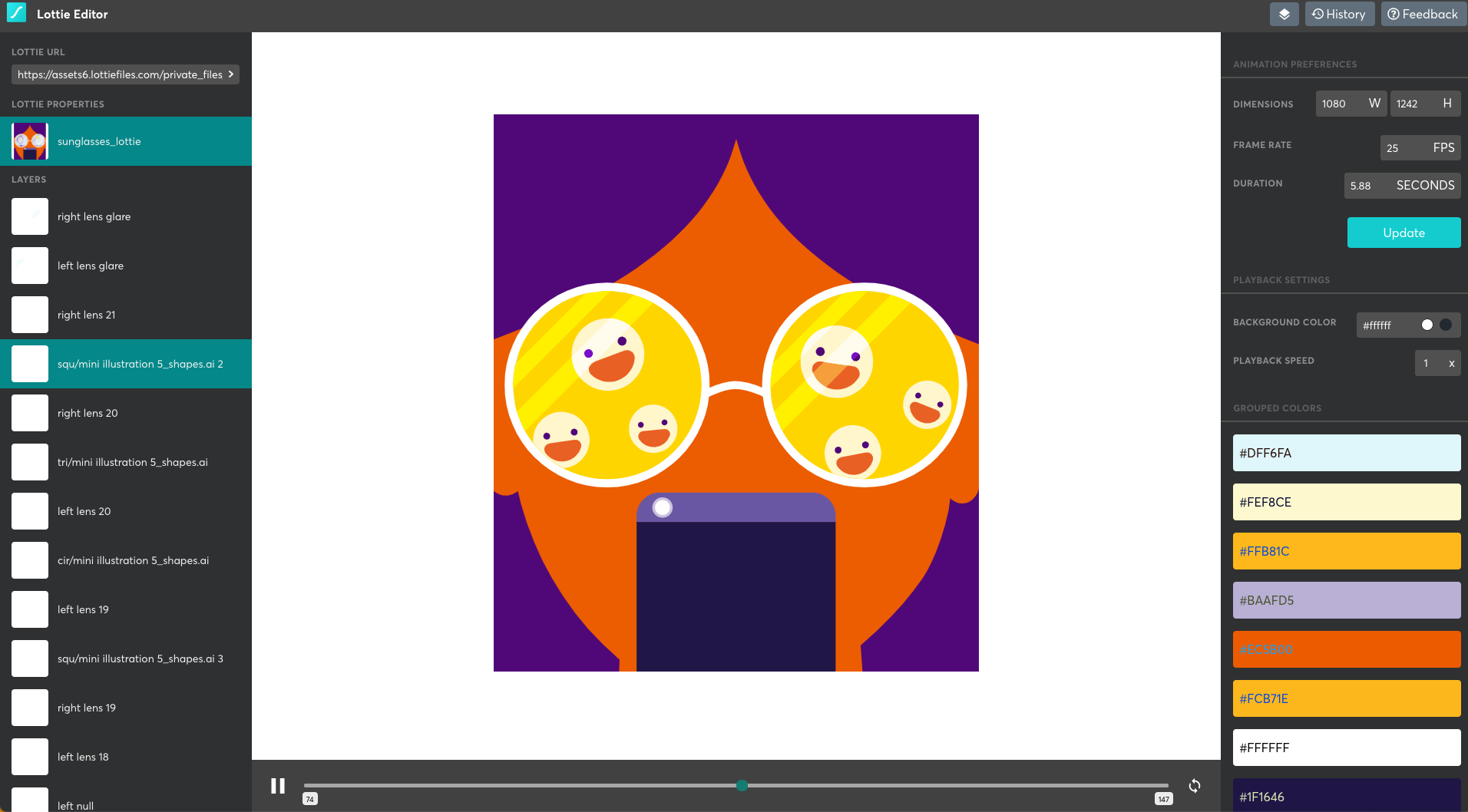
Image source: lottiefiles.com
And the best part? Lottie animations don’t require any knowledge of coding! You just need a Lottie player. Open-source and free Lottie players exist for the web, iOS, Android, Windows, QT, Tizen, and other platforms.
Lottie got its name from Charlotte’ Lotte’ Reiniger (2 June 1899 – 19 June 1981), a German film director and pioneer of silhouette animation. Her best-known films are The Adventures of Prince Achmed (1926), the first feature-length animated film, and Papageno (1935). She’s also known for devising the first form of a multiplane camera. The multiplane camera is a motion-picture camera that was used in the traditional animation process to create a sense of depth by moving a number of pieces of artwork past the camera at various speeds and various distances from one another.
The file format was invented and introduced in 2015 by Hernan Torrisi via his open-source Bodymovin plugin for the Adobe After Effects video animation and effects software. The Bodymovin plugin uses the scripting capabilities of Adobe After Effects and its document APIs to discover and walk through the frames and assets of a composition in Adobe After Effects and transform the animation to a JSON structure. Hernan Torrisi also released the first browser-based renderer for the format with a Javascript-based player.
In 2017, Airbnb engineers Brandon Withrow, Gabriel Peal, and Leland Richardson and lead animator Salih Abdul-Karim developed and launched Lottie, an iOS, Android, and React Native library that renders Adobe After Effects animations in real-time. Lottie uses animation data exported as JSON files from Hernan Torrisi’s Bodymovin plugin.

Animation by Jakob Winterholler
LottieFiles was launched soon after, and it is a platform for testing, collaborating, and discovering animations. The platform offers a range of tools, integrations, plugins, features, and a vast library of free Lottie animations ready to download and use (all of the animations featured in this article are from this library). LottieFiles is independent of Airbnb, but it runs on libraries created by the Airbnb developers mentioned above.
dotLottie was created in 2020 and is an open-source file format that aggregates one or more Lottie files and their associated resources into a single file.
As a marketer, you are always on the lookout for the most effective tools to enhance marketing for your brand and create the most exceptional user experience for your audience. If an image is worth a thousand words, then an animation is worth way more than that. By introducing motion to your content, you can grab attention quickly, enhance user engagement, simplify complex concepts, evoke emotions, create attractive user interfaces, strengthen your visual storytelling, and build a unique brand identity.

Animation by Kevin Domingo
Animation can work like magic to give more depth and perspective to your brand story and make static content more exciting and engaging. There’re many cases where animations can add to the user experience, not just from an aesthetic or brand perspective, but from feedback and functional point of view as well. The use of micro-animations in small elements like buttons, cursor movements, and loading graphics, for example, can improve the presentation of your website to your users drastically, keep them more engaged, and urge them to perform the desired actions.

Animation by Sanat Thakur
The use of animation isn’t only for your website and app. It can be an effective tool for all your marketing channels when precisely tailored to your target demographic. Take email marketing, for example. It’s a great way to connect with existing and prospective customers, showcase your products and services, and share updates about the company and future releases to keep the customers engaged and win their trust.
But email marketing can very easy turn spammy and make customers lose interest if it’s not done the right way. Adding motion to emails can help grab the customer’s attention, emphasise messaging and increase overall effectiveness. It can also make your emails more personalised. How about a custom animation for each audience segment, for example?

Animation by Smashing Stocks
Do you want to pitch a marketing strategy or campaign to a client successfully? Thorough market and competitor research are essential, but an eye-catching and engaging presentation is already as good as half the job done. And how can you achieve that? Simple. Add some motion to your marketing presentations and proposals. Animated infographics, for example, can pique your audience’s interest faster than static content, highlight vital information effectively and quickly by drawing the client’s attention to the most important elements, and help you convey complex ideas in a more relatable and engaging way.

Animation by Irfan Munawar
With 4.48 billion active users worldwide, social media is one of the most effective (if not THE most effective) digital advertising and branding tools in your brand’s marketing arsenal. A robust social media strategy can help you grow your audience and engage directly with them, increase brand awareness, drive traffic to your site or app, and generate leads and sales. Unfortunately, in today’s highly competitive and over-saturated social landscape, even the best copy is difficult to stand out.
That’s why you must support your copy with engaging visual content that cuts through the noise, makes your social media message more memorable, and provides users with a reason to interact with your brand and not your competitors. First of all, conduct market research to understand what your target audience likes to see and craft your content around that. And what’s the best way to create scroll-stopping social media posts if not by adding motion to your content. If you don’t have the means or the time to create long-form videos for your posts, using animation instead will give you that short, sharp, and memorable burst of visual content that grabs users’ attention as they scroll through their feed.
Another reason why a short animation could work better than a full-length video is that people’s attention span gets shorter and shorter. Since you can control the rhythm and volume of information in an animation better than in a live-action video, you can get more information across in a shorter space of time. And what about sound? A large percentage of social media videos will be viewed on mobile devices and without sound, as the volume is usually turned off by default. With animation, you can use on-screen text that will help convey the most important information even without sound.
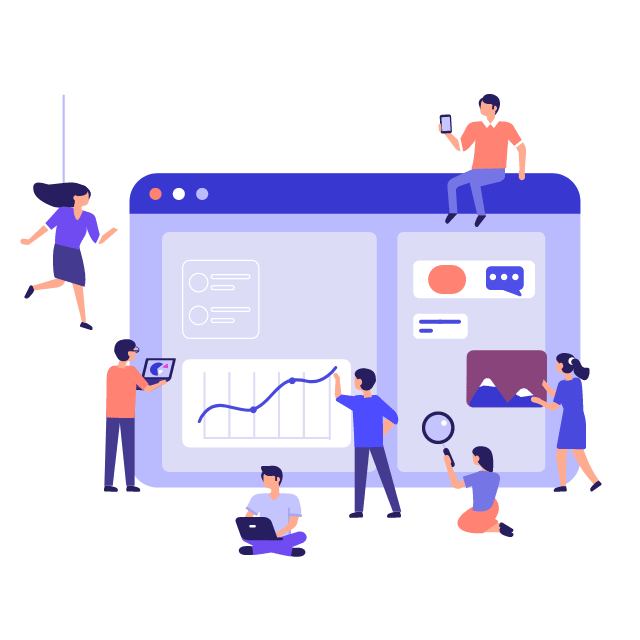
Animation by Lucas Stolz
We hope by now that you are convinced that animation is an excellent way of making static content way more exciting and engaging and grabbing customers’ attention in pretty much every digital marketing channel. But as we mentioned before, adding animation to your content that is flexible, works on any device and operating system, and loads fast can be a difficult and expensive task.
Choosing Lottie for your marketing animations can make animation implementation on any platform as easy and cost-effective as possible. Lottie can help you create user interfaces that are fast, dynamic and highly engaging and allow your marketing animations to have the biggest possible impact at the least possible cost.
A Lottie can play your animation on the Web or mobile devices while still maintaining a high level of quality and detail; it includes settings that allow for your animation to be interactive, it’s resolution independent and scalable at run-time, and its super small size allows for very fast loading times. You can use Lotties on basically any platform without modification, and they can even be used as stickers on messaging platforms.
Fanatic is a full-service creative agency based in Bristol, UK. We create engaging animations and videos that cut through the noise and get your message heard. Whether it’s communicating a complex message with an explainer video or infographic, or promoting your brand ideas with a bespoke designed animation, we got you covered!
The visualisation of your brand is the primary tool to express your message, and our graphic designers will weave your brand’s personality through each project with the understanding that every piece of material may be responsible for a user’s first enquiry.
It all starts with an idea. We research thoroughly, and then, armed with a clear understanding of the market, your target audience, and how your brand messages need to be communicated, our graphic designers bring them to life. We’ll throw concepts around and sketch things out until we are confident that the idea is fully formed and exactly right for each project’s objectives.
We love what we do and put the same passion and dedication into each animation project, no matter how big or small.
Specialist CRM agency Flourish has strengthened its commitment to putting the customer experience at the heart of everything it does with the appointment of former TSB and Bank of Ireland marketing head Emma Stacey as a non-executive director.
The move follows a recent management restructure at Flourish that has seen Ian Reeves appointed Managing Director. The new senior management team will maintain Flourish’s pragmatic approach to CRM, whilst expanding the use of data available through search and social to continually improve the relevance of customer led journeys.
Stacey will advise Flourish as the team look to consolidate their position and move into the next stage of their growth plan. Flourish will draw on Stacey’s vast experience, gained in the financial sector, of putting customers at the centre of every marketing experience, whilst achieving financial objectives.
Managing Director Ian Reeves said: “I am absolutely delighted to welcome Emma to the Flourish family. Our whole team and our clients will benefit from Emma’s wealth of knowledge. The ‘money confidence’ TSB campaign demonstrated the importance of data driven communications, something Flourish champion with all of our clients and I’m looking forward to Emma helping us as we onboard new clients in the future.”
Work is underway on the expansion of The Bottle Yard Studios into a neighbouring South Bristol industrial site, which is undergoing a £12m redevelopment backed by West of England Combined Authority investment that will add three new stages to the Studios’ portfolio.
Planned for completion this Summer, the expansion will increase the number of stages on offer at The Bottle Yard Studios from eight to 11 and is intended to maintain and grow film and TV production in Bristol and the West of England.
Titles recently filmed at the facility, the largest of its kind in the region, include upcoming BBC/Amazon psychological thriller Chloe (premiering Sunday 6 February), series one and two of Stephen Merchant’s BBC/Amazon series The Outlaws and BBC One legal drama Showtrial.
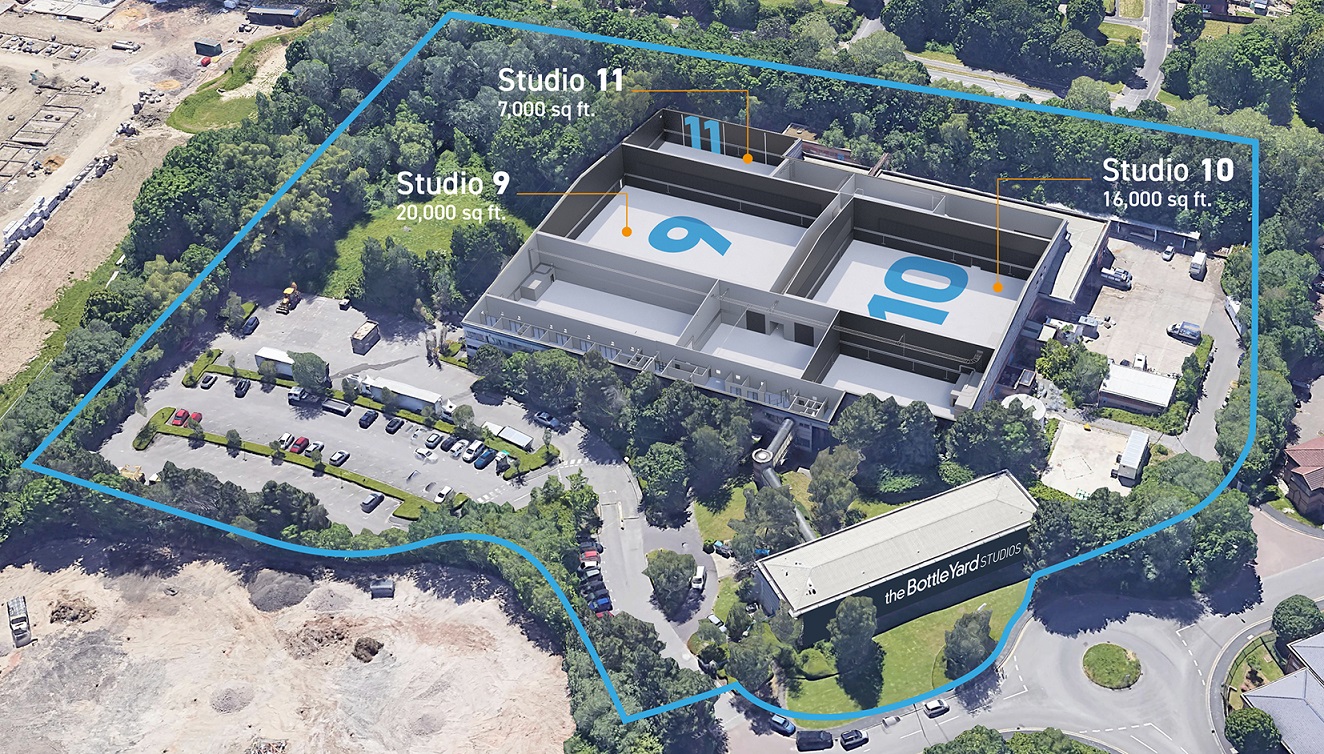
Global construction specialists ISG have been contracted by Bristol City Council to convert the industrial property at Hawkfield Business Park, less than half a mile from the main Bottle Yard site, into three new sound stages. Measuring 20,000 sq ft, 16,000 sq ft and 7,000 sq ft, the filming spaces will be accompanied by ancillary spaces including production offices, prop stores, costume/makeup areas and break out areas, amounting to approximately 82,000 sq ft (7,600m²) of converted floor space in total.
Operations at The Bottle Yard’s main site have also been boosted by a further £1.6m investment by Bristol City Council in renewal and repair works that will make the Studios’ existing buildings fit for purpose for the facility’s 10-year business plan.
Overall, the investment in the current site and new studio provision at Hawkfield Business Park is expected to create 135 jobs during the refurbishment with a further 863 jobs created over the next 10 years through an accompanying Workforce Development Programme focused on high-end TV skills and targeting development of new talent in South Bristol.
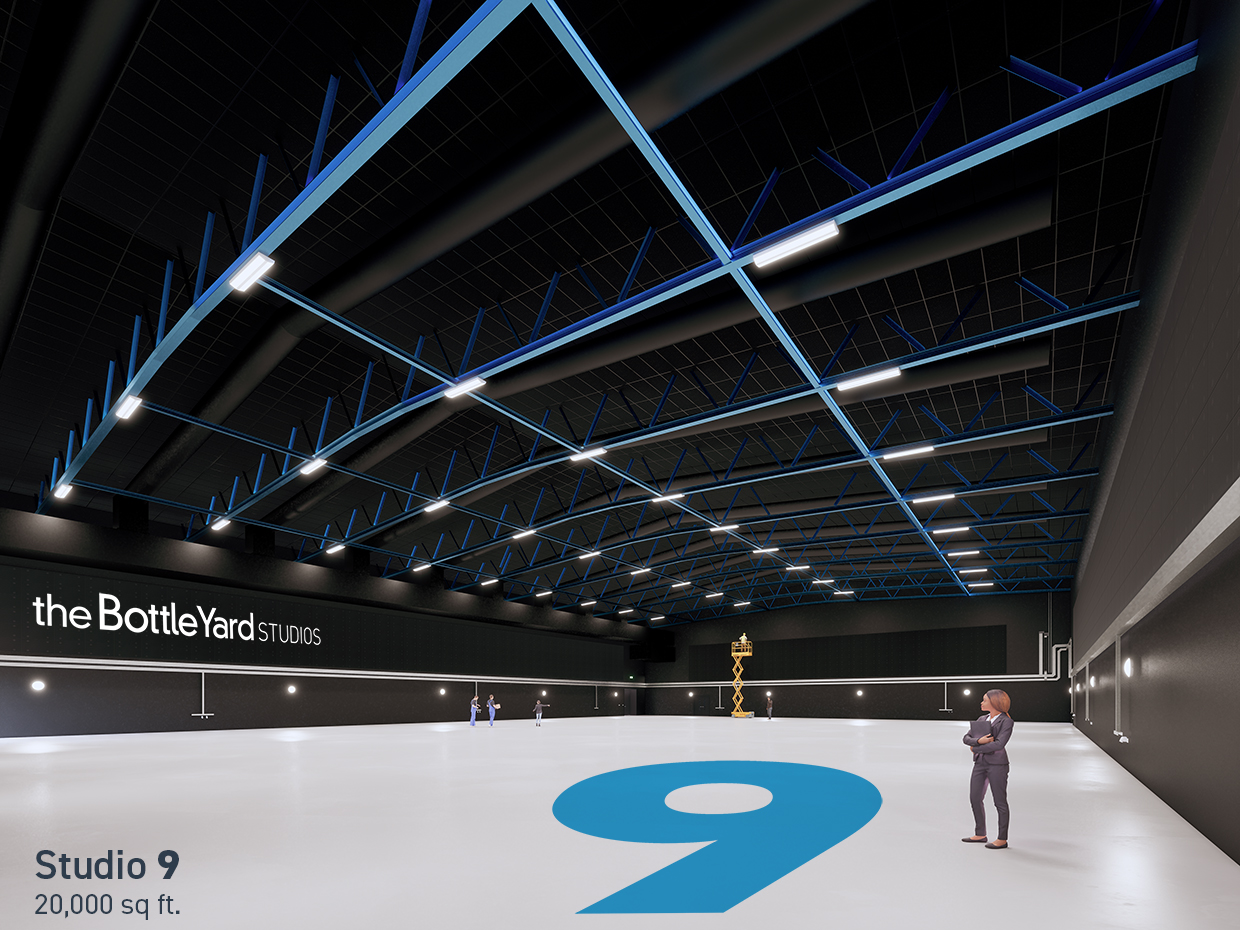
Dan Norris, mayor of the West of England, said:
“I’m incredibly proud of the investment that the West of England Combined Authority I lead is making here. It’s a fantastic space and the progress in getting it ready is remarkable. The expansion of The Bottle Yard studios sends a strong message that our amazing creative sector here in the West of England is thriving. So many talented people are helping put our region on the national and international map as a go-to location for the film and TV industry. Three new stages will mean even more of our favourite shows like The Outlaws, Poldark and Showtrial can be filmed here. This vote of confidence in the West of England will create a thousand high skilled jobs and should help us to attract even more production companies. I look forward to watching lots of new shows hit our screens, and I’ll enjoy them even more knowing they are made in the West of England.”
Marvin Rees, mayor of Bristol, said:
“It is great to see the expansion work starting at The Bottle Yard Studios. Our £1.6m investment in the current site, coupled with the additional capacity at the Hawkfield site, once developed, will bring confidence to the city’s film and TV production sector and harness growth as the demand for on-screen content grows worldwide. The expansion will also create jobs, skills and training opportunities, support the local supply chain and be a major boost to our wider regeneration plans for south Bristol, bringing growth and opportunity into the area.”
Laura Aviles, senior film manager for Bristol City Council which is responsible for The Bottle Yard Studios & Bristol Film Office, said:
“This expansion is big news for Bristol’s film and TV sector. Upping The Bottle Yard’s stage count from eight to 11 at a time when space for filming is at a premium, means we can welcome more of the productions we know are keen to film in Bristol, a city that saw a 225% increase in filming in the first quarter of the current financial year. We’re making sure Bristol seizes the opportunities presented by the UK production boom with both hands, so that local crew, companies and new generations of talent can reap the benefits in employment, business and skills development.”

Richard Skone, regional director for ISG, said:
“This highly significant creative arts scheme for Bristol is yet another example of smart and efficient procurement practice – fast-tracking the project to site through the use of the high-performing Southern Construction Framework (SCF). The sustainable Bottle Yard Studios development will prove transformative to the capacity and capability of the region’s media sector and, during the construction phase, will prioritise positive social value outcomes for local residents and the wider community. As the UK continues to benefit from a renaissance in investment in the creative arts sector, ISG brings significant expertise to this high-profile and ambitious project.”
Technical specifications for the new stages have been designed to a premium quality, with sound insulation between stages meeting cinema facility standards, impressive internal noise ratings (NR25 db) and reverberation levels of below 2 seconds. Stages will be clear span build spaces with maximum heights of 34ft, providing productions with adaptable studio accommodation of scale, ideal for meeting the needs of large-scale productions filming in and around Bristol.
Sustainability has been placed at the centre of the design and build process of the expansion site. Energy supply for the converted buildings will be supported by a large photovoltaic (PV) array, improved insulation and a sophisticated building management system designed to enable energy conservation. Transport around the Studios’ expanded footprint will be carbon neutral, with electric vehicle (EV) points and ample cycling provision supporting low carbon movement.
The expansion programme will also bring added benefits to local people through a series of training, skills and employability activities, apprenticeship opportunities and community project support co-ordinated by ISG as part of their contract.
Piers Tincknell, co-founder of WordPress and WooCommerce specialists Atomic Smash, is one of Bristol Creative Industries’ longest standing members. He joined in 2010 when his business was him and his co-founder David Darke. The company is now a team of 17.
Dan Martin spoke to Piers about his business journey and how BCI has played a key role in his success.
“My business partner David and I graduated from university with a digital arts degree. We had an assignment to come up with a hypothetical business that we might be able to run. Our idea was a podcasting network. We found that we worked really well together and when we graduated, we decided to set up our own actual business. We gave it three months. If we didn’t get any work or ran out of money, we’d get a proper job!
“We moved to Bristol but had no clients. We rented some desk space in Spike Island and immediately picked up work from other business people there. We were the only people in the space doing any form of web service so it was a rich source of collaboration. We did logo design, built websites, video editing, sound editing and 3D modelling. We did anything digital that people wanted us to do. We really got stuck in!
“A few years in we met someone who suggested we build our websites on WordPress as it was up and coming. We tried a few content management systems and decided WordPress was the one to use after a business adviser said that we needed to settle on a niche to be successful. It was also then that we hired our first employee.
“We posted a job ad on the Bristol Creative Industries job board. We received some applications and made a choice from those we interviewed. That person is still with us today.
“When you’re running a small business, it’s easy to hire the wrong person. Either you’re not going to pay enough money so you get somebody who’s too hard to manage and you need to upskill them so you can’t spend time on the high value work or you end up with somebody who’s not the right cultural fit.
“My advice around is to not panic hire. Don’t wait until you desperately need somebody to start the process of finding the right person. The longer the interview process and the more time you get to spend with somebody, the more likely you’re going to gel and find the right person. It will feel like a gamble because it’s a new fixed overhead, but if you need to think if the business is going in the right direction and you are going to have enough money in, say, six months time, let’s start the process as soon as possible.
“Doing it through Bristol Creative Industries is good too because you can keep recruitment costs down and I think it’s a more natural way of hiring. I totally see the room for recruiters when you’re a scale-up, but when you’re in your early stages and you’re all about building a good relationship with somebody, then doing it yourself can be so much better.”
“We never overtly set out our culture, but the culture we’ve ended up with is definitely a reflection of me and David as we are closely aligned. Our values are the same and that has been amplified into the business.
“Part of our company culture is learning and self development. We weren’t afraid to take on lots of different tasks at the beginning as we just wanted to learn and get stuck in. That has stuck with us and it’s something we encourage everyone in the business to do. Working in technology, you can’t sit still. You need to keep learning. That’s something we got from our university course. There was some software we studied in our first year that was obsolete by the final year!
“As your business grows, it’s really hard to hold onto your culture. I think at the beginning you just attract people who are similar to you. As you are working so closely together, often in the same room, you have to be really aligned to move forwards. When there’s 20 of you, it’s easy for everyone’s values to not quite align but you muddle through. Once you get to a certain size, the business owner needs to be much more overt about communicating their values internally and that messaging needs to be consistent.”
“We got lots of advice from other people at the start of our business journey. The top three tips were get some business insurance, find a mentor and join Bristol Creative Industries to meet new people.
“I’ve met loads of people through Bristol Creative Industries. In the early days, it was a way to get talking to a new contact if we were both members of BCI. It’s a great icebreaker. I’ve also been to lots of networking events over the years and attended programmes and other training.
“At the start when we didn’t have much money, membership was more of a commitment but we still saw the value in it. We enjoyed being able to connect with other business owners and realised Bristol Creative Industries was the best way to do that. As we’ve got bigger and we’ve become more self propelling, we want to give back. The money you give to BCI is about building Bristol as a community and promoting Bristol. We like that BCI is investing in the creative industries. It is so important for us so we want to do as much as we can to help promote it.”

“I think it’s more competitive than ever in the digital agency space. That’s a really big challenge.
“Talent is another one. It’s great that Bristol is growing in popularity and there are lots of big technology companies coming here, but they are hoovering up lots of good developers and designers. As a small business, we can’t compete on salary so we try and compete on other things that are important to people.
“It’s nice having such a great spread of clients because people often come to work for us to be able to get access to those clients. [Atomic Smash’s clients including Spike Island, Bristol Ideas and Bristol Pride]. That wasn’t an intentional, strategic thinking thing, it was just just a natural thing that happened.
“We also communicate the flexibility that we offer and let people know that if they come and work for us, their destiny is in their own hands. We encourage self-starters and if they’ve got ideas, they can run with them. If people are motivated and they want to take on a side project or they want to get a bit more involved in a particular area, they can.
“We also understand that employees are humans with complex lives. We’re flexible around things like taking 30 minutes in the middle of the afternoon to do the school run. My business partner and I have just got down to four days a week. I’ve got a son now so I’m balancing working and parenting. That is open to everyone. Our working week is a shorter than many other businesses as we contract people for 35 hours a week. If they want to condense it into four days, they are more than welcome to do so.”
“The best thing is the collaboration. That has enabled us to grow. We’ve done projects where we’ve worked directly with another agency. They’ve done some design work, and then we’ve done the implementation or vice versa. That has been of been one of the keys to our success.
“Bristol does collaboration really well, which is shown by the amount of people I’ve met through Bristol Creative Industries.
“The Bristol business culture is laid back. That’s great but it does mean that businesses are not always as good as those in other cities at self-promotion. If you look at it from the outside, it can seem like Bristol is not as hungry as cities like Manchester and London.”
“If we had set the business up in 2010 in our bedrooms and not in a workspace, there’s no way we would have met the people who gave us work at the start. Try and set up your new business in a hub or a workspace where there’s other people on the same journey and you’ve got mentors and advisers on hand.
“Find the best people if you’re going to take on staff. If they cost you a bit more, then it’s definitely worth it, and once they’re on board, look after them.
“Finally, I say enjoy the journey! It’s pretty up and down and it doesn’t end, so you’ve got to enjoy it as you go.”
Fancy joining Piers Tincknell as a Bristol Creative Industries member? Benefit from industry expertise, training, leads, curated news, kudos and more. Sign up here.
Michelin starred, restaurant quality pasta, delivered straight to your door. That’s the idea behind new recipe box venture, Otto. And as the fledgling service prepares to outgrow London town, they’ve turned to Bristol agency Flourish to lead the way to plates further afield.
Since launching in May last year, Otto has ramped up service – going from servicing just four London postcodes, to delivering right across the capital. And now, with big plans to expand outside of London, Flourish has been appointed the agency to help take exceptional pasta to the masses. And boy is there an appetite…
In 2020, the UK spent a huge £190m on fresh pasta and noodles (YouGov). And pasta accounted for just under 12% of evening meals (kitchen cooking index).
The popularity of recipe boxes has skyrocketed in the last few years, too. A Cardylicks study found of the 22 million UK bank accounts they analysed, 11 million purchased recipe boxes. It’s a market that was worth $10.6 billion globally in 2020, and it continues to grow.
But with growth comes competition. Otto will be going toe-to-toe with the likes of Pasta Evangelists and all kinds of other recipe box cuisines, so demonstrating value and quality will be top of the agenda.
Otto was founded by entrepreneur and Pots & Co founder Julian Dyer, and long-time collaborator and friend Phil Howard, Chef-Patron of Michelin-starred London restaurant Elystan Street.
Julian said of the recent partnership between Otto and Flourish: “We’re really excited about working with Flourish on taking Otto onto the next step of our journey.”
He added, “We have exciting plans for the retail side of Otto as well as the restaurant, working with Flourish will help us produce inspiring marketing campaigns to bring the brand to life and help us grow the business.”
Flourish has been a long-time supporter of challenger brands like Otto, albeit on a different scale – Samsung, ebay and Huawei to name a few big-hitters. And Flourish’s Managing Director Ian Reeves can’t wait to get stuck in:
“As a customer journey agency, the acquisition of new customers plays an important role for all of our clients, and especially for brands ready to expand, like Otto.”
He added, “We’re absolutely delighted to be working with Julian, Phil and the rest of the Otto team – their passion is infectious, and their pasta is unbelievably good.”
To find out more about our work with challenger brands, big and small, please get in touch.
You need to load content from reCAPTCHA to submit the form. Please note that doing so will share data with third-party providers.
More InformationNotifications